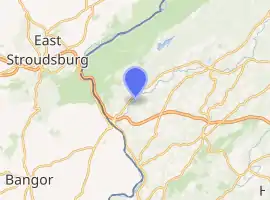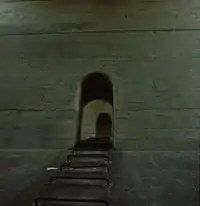Paulinskill Viaduct
The Paulinskill Viaduct, also known as the Hainesburg Viaduct, is a reinforced concrete railroad bridge that crosses the Paulins Kill in Knowlton Township, New Jersey.[1] When completed in 1910, it was the largest reinforced concrete structure in the world.
Paulinskill Viaduct | |
|---|---|
 A section of the Paulinskill Viaduct | |
| Coordinates | 40.9480°N 75.0613°W |
| Crosses | Paulins Kill |
| Locale | Hainesburg, New Jersey |
| Maintained by | New Jersey Department of Transportation |
| Characteristics | |
| Design | reinforced concrete arch |
| Total length | 1,100 feet (340 m) |
| Clearance below | 115 feet (35 m) |
| History | |
| Opened | December 24, 1911 |
| Closed | Still extant (railroad tracks removed in 1984) |
| Location | |

| |
History

The viaduct was built by the Delaware, Lackawanna and Western Railroad as part of the Lackawanna Cut-Off, a project that replaced an older route with a straighter and flatter route through the mountains of northwestern New Jersey. (A sister bridge of similar design but smaller dimension, the Delaware River Viaduct, carries the Lackawanna Cut-Off over the river, Interstate 80, and the New Jersey-Pennsylvania state line.) Designed by the DL&W's engineering staff under the supervision of chief engineer Lincoln Bush[2] and built by the Philadelphia contracting firm of Reiter, Curtis & Hill, the bridge was considered a pioneering work that opened the door to the building of even larger concrete viaducts by the Lackawanna, most notably the Tunkhannock Viaduct in Pennsylvania in 1915.
Opened to regular rail traffic on Christmas Eve 1911, the Paulinskill Viaduct, supported by its seven graceful arches, carried DL&W trains until 1960, when the railroad merged with the Erie Railroad to form the Erie Lackawanna Railroad. The E-L in turn operated the Cut-Off until 1976 when the railroad was conveyed into Conrail,[3] which ran trains until 1979, abandoned the line in 1982, and removed the tracks in 1984.
New Jersey Transit is working to restore commuter service along the Cut-Off, with the 7.3-mile (11.7 km) section from Lake Hopatcong, New Jersey, to Andover, New Jersey, currently under construction and slated to open in 2020. NJT has proposed to restore the rest of the Cut-Off, including the Paulinskill Viaduct, and restore passenger service into northeastern Pennsylvania, possibly as far as Scranton.
The Paulinskill Viaduct is also known for its internal chambers (used to inspect the structural integrity of the bridge), which are popular among those who enjoy urban exploration. The graffiti-filled chambers have been featured on Weird NJ.
Notes
- Taber & Taber 1980, p. 39
- Thompson, Sanford E. (1915). Concrete in Railroad Construction: A Treatise on Concrete for Railroad ... Atlas Portland Cement Company. p. 36.
- Taber & Taber 1980, p. 147
References
- Taber, Thomas Townsend; Taber, Thomas Townsend III (1980). The Delaware, Lackawanna & Western Railroad in the Twentieth Century. 1. Muncy, PA: Privately printed. ISBN 0-9603398-2-5.CS1 maint: ref=harv (link)
- Casey, Robert J.; Douglas, W. A. S. (1951). The Lackawanna Story - The First Hundred Years of the Delaware, Lackawanna and Western Railroad. McGraw-Hill Book Company.
External links
- The Wonders of Paulinskill Viaduct at weirdnj.com
- Jennings, Rob (November 3, 2019). "This N.J. rail bridge is beloved by many, but nobody knows what to do with it". nj.
- Paulinskill Viaduct at Structurae